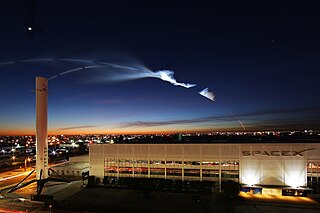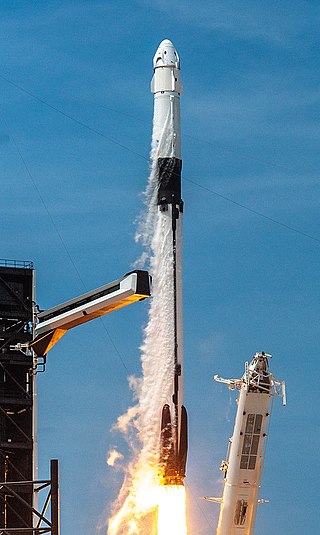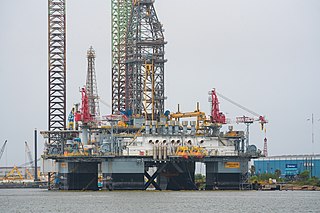Related Research Articles

Atmospheric entry is the movement of an object from outer space into and through the gases of an atmosphere of a planet, dwarf planet, or natural satellite. There are two main types of atmospheric entry: uncontrolled entry, such as the entry of astronomical objects, space debris, or bolides; and controlled entry of a spacecraft capable of being navigated or following a predetermined course. Technologies and procedures allowing the controlled atmospheric entry, descent, and landing of spacecraft are collectively termed as EDL.

Space Exploration Technologies Corp. (SpaceX) is an American spacecraft manufacturer, launcher, and a satellite communications corporation headquartered in Hawthorne, California. It was founded in 2002 by Elon Musk with the stated goal of reducing space transportation costs to enable the colonization of Mars. The company manufactures the Falcon 9, Falcon Heavy, and Starship launch vehicles, several rocket engines, Cargo Dragon and Crew Dragon spacecraft, and Starlink communications satellites.

Vertical takeoff, vertical landing (VTVL) is a form of takeoff and landing for rockets. Multiple VTVL craft have flown. The most widely known and commercially successful VTVL rocket is SpaceX's Falcon 9 first stage.

Cargo spacecraft are robotic spacecraft that are designed to carry cargo, possibly to support space stations' operation by transporting food, propellant and other supplies. This is different from a space probe, whose missions are to conduct scientific investigations.

SpaceX is privately funding the development of orbital launch systems that can be reused many times, in a manner similar to the reusability of aircraft. SpaceX has been developing the technologies over several years to facilitate full and rapid reusability of space launch vehicles. The project's long-term objectives include returning a launch vehicle first stage to the launch site in minutes and to return a second stage to the launch pad following orbital realignment with the launch site and atmospheric reentry in up to 24 hours. SpaceX's long term goal is that both stages of their orbital launch vehicle will be designed to allow reuse a few hours after return.

Mars atmospheric entry is the entry into the atmosphere of Mars. High velocity entry into Martian air creates a CO2-N2 plasma, as opposed to O2-N2 for Earth air. Mars entry is affected by the radiative effects of hot CO2 gas and Martian dust suspended in the air. Flight regimes for entry, descent, and landing systems include aerocapture, hypersonic, supersonic, and subsonic.

The SpaceX Red Dragon was a 2011–2017 concept for using an uncrewed modified SpaceX Dragon 2 for low-cost Mars lander missions to be launched using Falcon Heavy rockets.
The SpaceX Mars program is a set of projects through which the aerospace company SpaceX hopes to facilitate the colonization of Mars. The company claims that this is necessary for the long-term survival of the human species and that its Mars program, including the ongoing development of the SpaceX Starship, will reduce space transportation costs, thereby making travel to Mars a more realistic possibility.

The Crew Module Atmospheric Re-entry Experiment (CARE) is an experimental test vehicle for the Indian Space Research Organisation's future ISRO orbital vehicle called Gaganyaan. It was launched successfully on 18 December 2014 from the Second Launch Pad of the Satish Dhawan Space Centre, by a GSLV Mk III designated by ISRO as the LVM 3X CARE mission. Total cost of mission was ₹155 crore. Cost of launch vehicle and CARE module was ₹140 crore and ₹15 crore.

SpaceX CRS-18, also known as SpX-18, was SpaceX's 18th flight to the International Space Station under the Commercial Resupply Services program for NASA. It was launched on 25 July 2019 aboard a Falcon 9 rocket.

SpaceX Starship development began in 2012, when Elon Musk, CEO of American aerospace company SpaceX, first publicly described a high-level plan to build a reusable rocket system with substantially greater capabilities than the Falcon 9 and the Falcon Heavy. The rocket evolved through many design and name changes. On 25 July 2019, the Starhopper prototype performed the first successful flight at SpaceX Starbase near Boca Chica, Texas. The SN15 prototype rocket was the first full size test spacecraft to take off and land successfully, in May 2021.
Starship is a fully-reusable, super-heavy-lift launch vehicle being developed by American aerospace company SpaceX. If successful, Starship will be the most powerful launch vehicle ever built and is expected to be the first to demonstrate total reusability.

Falcon 9 Block 5 is a partially reusable two-stage-to-orbit medium-lift launch vehicle designed and manufactured in the United States by SpaceX. It is the fifth version of Falcon 9 Full Thrust, powered by SpaceX Merlin engines burning rocket-grade kerosene (RP-1) and liquid oxygen (LOX).

The Tesla Cybertruck is an upcoming battery electric light-duty truck announced by Tesla, Inc. in 2019. Three models have been announced, with EPA range estimates of 400–800 kilometers (250–500 mi) and an estimated 0–100 km/h (0–62 mph) time of 2.9–6.5 seconds, depending on the model.

Raptor is a family of full-flow staged-combustion-cycle rocket engines developed and manufactured by SpaceX for use on the in-development SpaceX Starship. The engine is powered by cryogenic liquid methane and liquid oxygen ("methalox") rather than the RP-1 and liquid oxygen ("kerolox") used in SpaceX's prior Merlin and Kestrel rocket engines. The Raptor engine has more than twice the thrust of SpaceX's Merlin 1D engine that powers the Falcon 9 and Falcon Heavy launch vehicles.

Autogenous pressurization is the use of self-generated gaseous propellant to pressurize liquid propellant in rockets. Traditional liquid-propellant rockets have been most often pressurized with other gases, such as helium, which necessitates carrying the pressurant tanks along with the plumbing and control system to use it. Autogenous pressurization has been operationally used on the Titan 34D and the Space Shuttle. Autogenous pressurization is planned to be used on the SLS, Starship, New Glenn, Terran 1, ACES upper-stage and Rocket Lab's Neutron rocket.

Starship HLS, or Starship Human Landing System, is a lunar lander variant of the Starship spacecraft that will transfer astronauts from a lunar orbit to the surface of the Moon and back. It is being designed and built by SpaceX under contract to NASA as a critical element of NASA's Artemis program to land a crew on the Moon in the 2020s.

SpaceX's Starship offshore platforms—Deimos and Phobos—are former deepwater oil drilling rigs. In January 2021, SpaceX began modifying them to support launch and landing of their next-generation launch vehicle, Starship. Both platforms are part of the Ensco 8500 Series Semi Submersible-type.
References
- 1 2 3 https://www.teslarati.com/spacex-ceo-elon-musk-starship-transpiring-steel-heat-shield-interview/ Archived 2019-01-24 at the Wayback Machine SpaceX CEO Elon Musk explains Starship's "transpiring" steel heat shield in Q&A], Eric Ralph, Teslarati News, 23 January 2019, accessed 30 January 2019
- 1 2 Transpiration Cooling Archived 2019-01-30 at the Wayback Machine , Thermopedia.com, accessed 30 January 2019.
- 1 2 Ifti, Hassan Saad; Hermann, Tobias; McGilvray, Matthew (15 September 2018). "Flow Characterisation of Transpiring Porous Media for Hypersonic Vehicles". 22nd AIAA International Space Planes and Hypersonics Systems and Technologies Conference. AIAA SPACE Forum. American Institute of Aeronautics and Astronautics. doi:10.2514/6.2018-5167. ISBN 978-1-62410-577-7. S2CID 139312401.
- ↑ Transpiration Cooling Systems for Jet Engine Turbines and Hypersonic Flight Archived 2020-08-02 at the Wayback Machine , accessed 30 January 2019.
- 1 2 Shine, S.R.; Nidhi, S.Shri (2018). "Review on film cooling of liquid rocket engines". Propulsion and Power Research. 7: 1–18. doi:10.1016/j.jppr.2018.01.004.
- ↑ Keener, D.; Lenertz, J.; Bowersox, R.; Bowman, J. (1995). "Transpiration cooling effects on nozzle heat transfer and performance". Journal of Spacecraft and Rockets. 32 (6): 981–985. Bibcode:1995JSpRo..32..981K. doi:10.2514/3.26718.
- ↑ Hermann, T.; Ifti, H. S.; McGilvray, M.; Doherty, L.; Geraets, R.P. (26 November 2018). Mixing characteristics in a hypersonic flow around a transpiration cooled flat plate model. Archived from the original on 10 October 2020. Retrieved 10 October 2020.
- 1 2 Gebhardt, Chris (3 April 2019). "Starhopper conducts Raptor Static Fire test". NASASpaceFlight.com . Archived from the original on 4 April 2019. Retrieved 4 April 2019.
Transpiration cooling is the act of pumping coolant – in this case, liquid methane – through the skin structure of Starship to absorb additional heat in particular areas of the vehicle during reentry.
- ↑ https://www.space.com/43101-elon-musk-explains-stainless-steel-starship.html Archived 2019-02-03 at the Wayback Machine Why Elon Musk Turned to Stainless Steel for SpaceX's Starship Mars Rocket], Mike Wall, space.com, 23 January 2019, accessed 30 January 2019.
- ↑ "SpaceX's steel Starship glows during Earth reentry in first high-quality render". 26 March 2019. Archived from the original on 2019-03-26. Retrieved 2019-03-26.
- ↑ SpaceX Starship Will "Bleed Water" From Tiny Holes, Says Elon Musk Archived 2019-01-24 at the Wayback Machine . Kristin Houser, Futurism. 22 January 2019.
- ↑ Could do it, but we developed low cost reusable tiles that are much lighter than transpiration cooling & quite robust Archived 2019-09-24 at the Wayback Machine , Elon Musk, 24 September 2019, accessed 24 September 2019.
- ↑ Ralph, Eric. "SpaceX tests ceramic Starship heat shield tiles on Starhopper's final flight test". Teslarati. Archived from the original on 24 September 2019. Retrieved 8 September 2019.
- ↑ Q: Are you still considering transpiration cooling for most vulnerable hotspots or are the heat shield tiles tough enough? A: It might be used in some areas. ITAR laws prevent us from being too specific about solutions. Archived 2020-10-10 at the Wayback Machine , Elon Musk, 9 October 2020, accessed 10 October 2020.